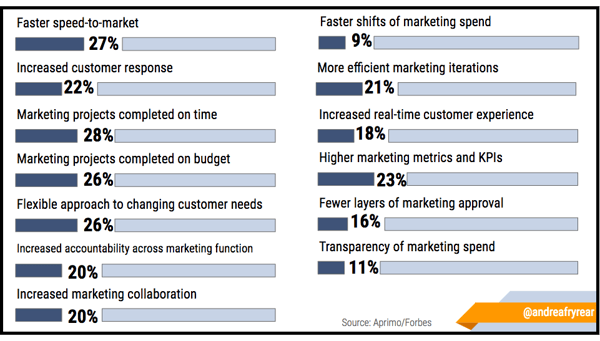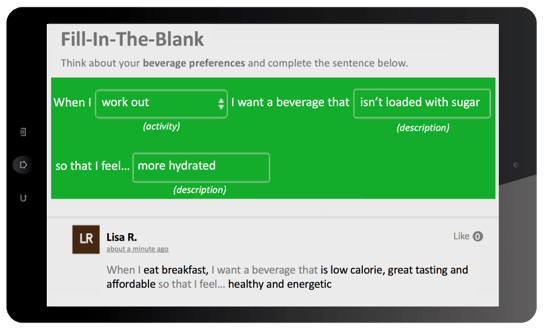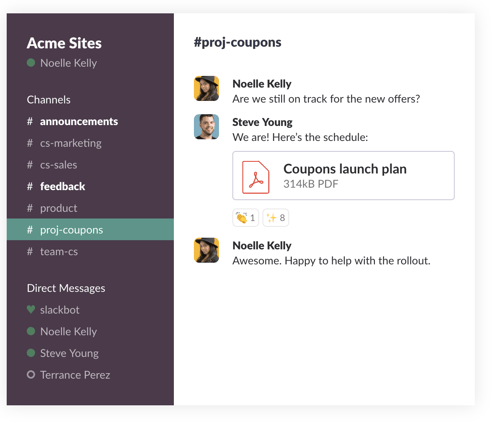Today’s most effective marketing and insights leaders are empowering their teams to solve really challenging business problems without getting bogged down in process. Learn how your team can be more agile—including modern tools that can help drive team collaboration, rapid iteration and ultimately faster time to market.
Main Takeaways:
-
Agile is not just about speed - learn what agile means for marketing teams, and the tangible benefits marketers have achieved through applying agile principles.
-
Find practical ways to get started - we provide specific examples of tools your team can leverage in your quest to be nimbler and more collaborative.
Today’s leading marketing teams are increasingly adopting an agile approach.
This, in large part, is due to the myriad of benefits agile provides. Consider the following statistics:
- 93% of CMOs that use agile tactics say they are able to bring products and campaigns to market faster
- 28% of senior marketers say more projects get completed on schedule after agile has been adopted
- 93% of CMOs say their agile teams are able to pivot faster
- 21% of senior marketers say they are able to iterate more effectively and efficiently with an agile approach
 [source: https://www.agilesherpas.com/benefits-of-agile-marketing/]
[source: https://www.agilesherpas.com/benefits-of-agile-marketing/]
- 87% of CMOs indicate that team productivity increased following a switch to agile
What exactly differentiates an agile approach from a more traditional one?
The agile marketing manifesto outlines seven values of the new way of working:
- Validated learning over opinions and conventions
- Customer-focused collaboration over silos and hierarchy
- Adaptive and iterative campaigns over Big-Bang campaigns
- The process of customer discovery over static prediction
- Flexible vs. rigid planning
- Responding to change over following a plan
- Many small experiments over a few large bets
Essentially, agile is a new way of looking at things. Instead of following a plan you put together a month ago that may or may not be working, agile involves engaging with consumers often, responding to change and pivoting when needed.
The Benefits of Agile Marketing
While agile isn’t simply about moving faster, it does help speed things up. For starters, agile marketing teams are able to accomplish more of the right things. It’s one thing to get a lot of work done. It’s quite another thing to get the work done that brings you the results you’re looking for.
.png?width=512&name=Geometric%20Venn%20Diagram%20(2).png)
Agile also enables teams to respond to change and adapt to uncertainty. Customers’ perceptions of your big idea might shift as your new product or marketing program gets flushed out. Agile teams are able to leverage feedback and quickly adjust their plans, thereby increasing the chances their efforts are successful.
What’s more, because agile prioritizes collaboration rather than go-no-go type decisions from those not involved, agile teams tend to become stronger. This increases organizational effectiveness while positioning teams to deliver exemplary customer experiences.
Getting Started with Agile
The benefits of agile speak for themselves. But how exactly do you get started? It starts with a mindset shift. If your team doesn’t buy in to agile, your efforts won’t likely succeed.
So first things first: You need to sell agile to your team internally. Get them on board with the concept of a sprint, which is generally a two-week period during which the most critical priorities are earmarked for completion. Sprints allow teams to direct their focus more narrowly, which makes their jobs easier and their finished work products stronger.
In addition to a mindset shift, agile also requires the right set of tools.
.png?width=568&name=Teal%20Simple%20Comparison%20Chart%20(6).png)
1. Digsite for agile research
One major challenge with agile can be getting consumer feedback within 2 week sprint cycles. Digsite delivers a fast, affordable way to find and engage your customers online. The platform enables you to recruit customers quickly and offers automated reporting functionality—so you can put your data to use right away. More than a survey, Digsite uses a social media style interface with a mix of moderated and unmoderated activities to get unbiased feedback and to dig deeper into understanding the context and “why’s”.
The platform can be used to test products, concepts, marketing campaigns and more with a targeted group of consumers. You can gauge their reactions and iterate based on their feedback within a single study.

Digsite offers a variety of activities you can use depending on what the task at hand calls for, including group and private discussions, video and photo sharing, image markup, voting and open- and closed-ended survey questions.
2. Trello for sprint tracking
Helping the team have continuous visibility to the status of your Sprints can be challenging, particularly with remote teams. Trello is a collaboration platform that supports sprint tracking for marketing teams. You can use Trello to manage projects visually under the kanban framework of development.
Trello enables you to organize projects by “cards” and columns, moving them along as they get closer to completion. For example, you might create columns called “Ideas,” “To Do,” “In Progress,” “Needs Review” and “Complete.”
.png?width=2290&name=unnamed%20(1).png) [source: https://trello.com/home]
[source: https://trello.com/home]
The platform gives your team instant visibility into the status of projects and activities. Everyone can easily see where things stand at any given point in time, providing your team with complete transparency.
3. MURAL for design sprint management
Google pioneered Design Sprints as an agile approach to ambiguous problems quickly. MURAL supports collaborative design by enabling users to create, modify and move virtual sticky notes in a digital team environment. Designers can jot down quick ideas on stick notes and supplement them with visual aids and other content before sharing them with their team. Teammates can then offer feedback to improve each design.
The platform allows peers to easily collaborate with one another and track changes to see how ideas evolve over time. MURAL also offers several templates that enable teams to facilitate remote design sprints from anywhere they happen to be.
4. RealtimeBoard for agile creative development
Mapping the customer journey and prioritizing where you can make the most impact is a critical function for marketing and CX teams. RealtimeBoard is an online whiteboarding platform that supports agile creative development for cross-functional team collaboration. Similar to Mural and Trello, the tool helps teams see their concepts through from ideation to wireframing to completion by enabling them to collaborate effectively, visualize their designs and share their ideas with ease.
RealtimeBoard also comes with several built-in templates that make it easy to visualize research results, including one for journey mapping. Teams that use the platform can get up and running in no time.
.png?width=1298&name=unnamed%20(3).png) [source: https://realtimeboard.com/
[source: https://realtimeboard.com/
5. Slack for agile collaboration
Slack is an agile collaboration platform that brings remote and cross-functional teams together quickly to discuss ideas, share files, collaborate on projects and simply chat. Teams can even invite outside vendors to participate in the conversation.
The platform enables teams to organize their conversations by channel. For example, you might create a channel for each campaign and each client. That way, it’s easy to find the information you’re looking for—which saves time and frustration. Important content can also be pinned to the top of each channel so it can easily be referenced later.

[source: https://slack.com/features]
Slack helps employees stay in the loop without having to participate in never-ending email chains. The platform also offers emoji support and quick polls that enable you to get everyone’s input quickly.
What’s more, Slack serves as a persistent record of what happened; new users can get up to speed quickly on their own while other team members can see what their colleagues are working on without having to bother them.
Increase Your Competitiveness with Agile
Agile tools have the power to transform your marketing team—enabling you to achieve better results in a more efficient manner. By convincing your team that agile principles are right for your organization—and arming them with an array of agile tools, like Digsite, MURAL, RealtimeBoard, Slack and Trello—you can easily transform into an agile marketing team. As a result, your employees will be more engaged, your customers will be happier and your bottom line will be stronger.
Learn more about how Agile research tools can get you the insights you need - fast.

.png?width=1352&name=unnamed%20(2).png) .
. 



